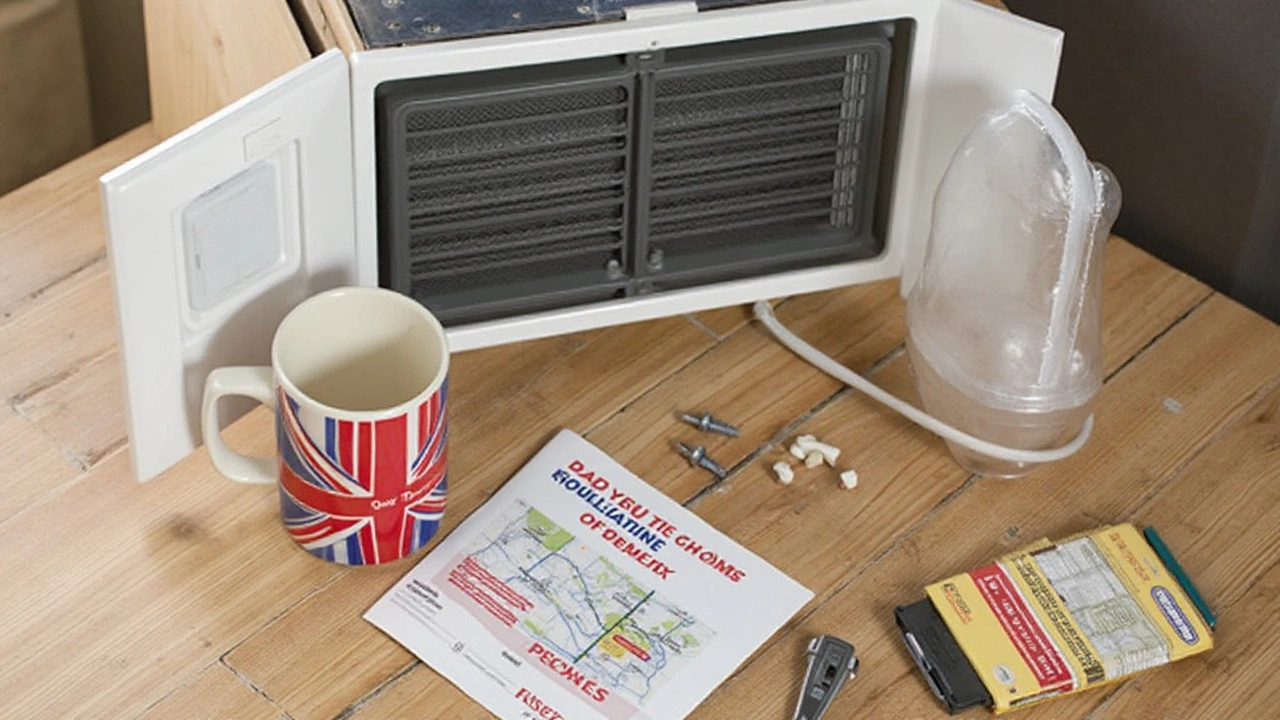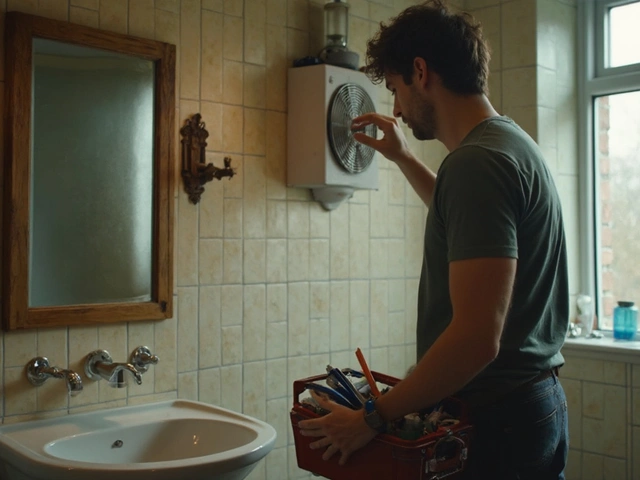Extractor fans are silent workers in our homes, tirelessly expelling unwanted air and ensuring good circulation, be it in your kitchen or bathroom. When they suddenly decide to stop doing their job, it’s more than just an inconvenience. The lingering odors or excess moisture they leave behind can disrupt the harmony of your living space. But fear not, because solving this issue might be easier than you think.
This article will guide you through a series of hands-on steps to get your extractor fan back up and running. No need for hefty service charges or endless waiting for a technician—sometimes the most effective solutions are right at your fingertips. Let's dive into some practical tips and tricks that might just save your sanity and ensure your air stays fresh and breathable.
- Understanding the Importance of Extractor Fans
- Initial Troubleshooting Steps
- Checking Electrical Connections
- Cleaning and Maintenance Tips
- When to Replace Parts
- Professional Help and Safety Tips
Understanding the Importance of Extractor Fans
Extractor fans hold a crucial role in the architecture of modern homes, particularly in areas like kitchens and bathrooms where moisture, smells, and smoke are prevalent. These mechanical wonders are designed not just for comfort, but for safeguarding your home as well. Their first priority is to remove excess moisture, which, if left unchecked, can lead to unsightly mold growth and even structural damage over time. Mold infestations don’t just result in unpleasant odors; they can also trigger allergies and other respiratory problems, significantly affecting indoor air quality.
For many, the function of an extractor fan goes unnoticed until it stops working. Kitchens, especially, can become quite a challenge without the silent warrior above the stove. From frying chicken to simmering a rich curry, smells can linger longer than desired, embedding themselves into fabrics and creating an unwelcome experience. Beyond personal discomfort, these devices ensure that your indoor air remains breathable and healthy by efficiently channeling unwanted elements outside.
In bathrooms, extractor fans are indispensable in tackling humidity. The constant cycle of hot showers transforms bathrooms into potential greenhouses for fungi. By actively ventilating humid air out, these fans prevent dampness from affecting walls, paint, and even the wooden structures beneath. A properly functioning fan can save thousands in potential repair costs caused by water damage. As Bruce S. Cotterill once noted, "Prevention is not just better but more accessible than most cures."
Interestingly, these fans are designed to be energy efficient while handling large volumes of air. Advances in technology have brought forth models that not only do their primary job of ventilation seamlessly but also contribute to energy savings. Some modern models come equipped with sensors to adjust their operation based on humidity levels, ensuring they run only when necessary, which can contribute significantly to lowering energy bills. Having an efficient extractor fan is critical to optimizing home energy usage.
The repair and maintenance of these units is, thus, a topic of significant concern. A well-maintained extractor fan is pivotal for ensuring it continues to perform optimally. Regular cleaning, for instance, ensures that dust and grease do not build up, which can otherwise impede the functionality of the fan over time. Understanding how these devices fit into the broader maintenance picture is essential for homeowners looking to prolong their fan's lifespan and maximize its operational efficiency.
Thus, with such crucial roles to play, ensuring the optimal functionality of your extractor fan isn’t merely about comfort—it's an investment in the safety and health of your home. Whether you’re tackling kitchen odors or managing bathroom moisture, these fans are your first line of defense, safeguarding both your property and your well-being. Understanding and appreciating their importance can go a long way in encouraging proactive care and ensuring your home remains the sanctuary it is meant to be.
Initial Troubleshooting Steps
The first thing you’ll want to do when your extractor fan is on the fritz is not to panic. A fan that doesn’t budge might seem catastrophic, but the culprit could be more benign than you’d think. Begin by examining the simplest factor: power. Is the unit plugged in properly? The connection between the fan and the outlet should be secure. Often disrupted by a playful tap, these connections might seem insignificant, yet they hold the key to many a mystery in household repairs.
Let’s shift focus to the control switches. Ensure that the wall switch is in the 'on' position. If your fan is equipped with a remote control, replace its batteries—sometimes it's as straightforward as that. In most cases, insufficient power is a result of a blown fuse or tripped circuit. So the next logical step is to check your breaker panel to ensure that the circuit hasn’t been switched off. You’d be surprised at how often this tiny trip yields big drama. Reset the breaker if you find it tripped. But what if nothing reveals itself with these checks?
This curiosity might just lead you to an issue with the fuse connected to your extractor fan. If your fan's fuse has blown, it could be due to a spike in electricity or a serious component failure. Replacing a fuse might sound daunting but it's simple when done carefully. Make sure you know the model of your fan and replace fuses only with those recommended by the manufacturer. Double-check the wattage requirements to avoid a repetitive burnout. If done correctly, these steps can quickly determine if the problem is within reach of a quick fix.
Sensing the Smaller Problems
Once the basics are out of the way, it’s time to think smaller: the fan blades. The smooth operation of an extractor fan greatly depends on the free flow of its blades. Dust and debris accumulation can hinder blade rotation, leading to a nervous whirr or complete standstill. Take some time to inspect areas that might be hidden from easy view. Use a flashlight to peer into the unit and establish whether you see anything unusual. Often, what stands seemingly hidden are the simplest of blockages.
If you’re ready to get your hands dirty, gently remove dust with a clean, soft brush or compressed air. Be certain that your fan is disconnected from power to avoid any unwelcome surprises. You’d be astonished at the significant impact a simple cleaning session can have. A well-maintained set of blades paves the way for your fan's optimum operation. Frequent maintenance can thwart countless potential frustrations ahead of time.
“A well-maintained fan is a quietly efficient appliance,” says renowned home improvement expert, Dan Gregory, reminding us of the importance of regular care.
This task of ensuring free movement extends to any moving parts within the fan mechanism. The aim is to prevent resistance that can stop your fan in its tracks. By incorporating these initial troubleshooting steps, you’re laying the groundwork for a promising result. Such simple checks can return your fan to its role as the unsung hero of home's air quality.

Checking Electrical Connections
When your extractor fan gives up on you right in the middle of dinner preparation or a steamy shower, it’s tempting to wish for a magic wand to fix it. But before thinking about swapping parts or buying a new one, the electrical connections are the first suspects you should inspect. Often, what seems like a daunting technical issue is a simple electrical hiccup that anyone can understand and possibly fix themselves. As a rule of thumb, always start with the power source; it’s the lifeblood of your extractor fan. A loose connection or a tripped circuit breaker can halt the fan's operation. Begin by ensuring the electricity supply to the house is intact and not affected by an outage.
Once the power is confirmed, the next step involves the circuit breaker or fuse specifically related to the fan's circuit. Many houses have a separate breaker for kitchen or bathroom appliances. If your fan isn’t starting, the breaker might have tripped, which is a common issue and easily resolvable. Simply reset it and check if the fan begins operating again. It might seem trivial, but breakers can trip due to multiple high-demand appliances running simultaneously.
Moving on to more specific checks, the wiring itself often bears the culprit when your fan refuses to cooperate. Open up the fan cover and inspect for any visible signs of damaged wiring. Whether it is frayed wires or melted insulation, such faults require immediate attention. Luckily, fixing the wiring might just involve tightening loose connections or replacing external wires that suffered wear and tear over time.
As John Smith, a renowned electrician, remarks, “In my years of fixing, nine times out of ten, it’s a small electrical glitch costing less than a cup of coffee to repair.”
Being meticulous about electrical connections also means checking the switch controlling the extractor fan. Faulty switches wear out faster than you’d expect, particularly if they constantly operate high-power appliances. Test the switch using a multimeter to ensure it’s functioning correctly. Swapping out a faulty switch with a new one is less complicated and inexpensive than you might think.
Lastly, consult the user manual for specific instructions related to your extractor fan’s electrical setup. Manufacturers occasionally pack in troubleshooting tips unique to the fan model. This overlooked piece of documentation can clarify things in a way an online search never could, saving unnecessary confusion or misdiagnosis. So, before diving into more complex repairs, always give your electrical connections the once-over—they might just reveal the solution right under your nose!
Cleaning and Maintenance Tips
Regular cleaning and maintenance of your extractor fan are crucial for its longevity and efficiency. The very nature of these devices means they collect a fair amount of dust, grease, and other residues over time, which can lead to reduced performance or eventual breakdowns. Start by ensuring the fan is safely isolated from the power source before you begin any cleaning. This precaution not only protects you but also prevents any accidental damage to the fan's mechanisms. Once you are sure the power is off, removing the cover or grille is your first step, typically done by unscrewing it or releasing clips, depending on the model. Clean these parts with warm soapy water to remove any built-up grime.
As you move deeper into the cleaning process, consider using a vacuum with a nozzle attachment to gently suction out dust and debris from around the fan blades and motor. Be careful not to disturb the wirings and components within the housing. If you find a significant amount of grease or dirt on the fan blades, a mild detergent can be used with a soft brush to scrub them clean. Regularly cleaning these parts not only helps maintain the fan's efficiency but also prolongs its lifespan. Remember, a clean fan is a happy fan, efficiently working to keep your home air fresh and ventilation appropriate.
Inspection of the filter is another crucial step in extractor fan maintenance. Many fans, especially those installed in kitchens, come with grease filters that need regular cleaning or replacement. A congested filter means the fan has to work extra hard, which often leads to motor strain and potential burnout. Removing the filter can typically be done by sliding it out or unhooking it. Wash it thoroughly if it's a reusable model, or replace it if it's a disposable one. You'll notice an immediate difference in airflow when the filter is clean and free of obstructions. Keeping the filter clean also aids in managing odors and improves air quality significantly.
“Cleaning and maintaining your fan is like an ounce of prevention being worth a pound of cure,” says John Campbell, a veteran HVAC technician based in London. “Regular care can save you costly repairs or replacements down the road.”
It's beneficial to schedule routine check-ups, perhaps every three to six months, depending on your usage and the environment in which the fan operates. Doing so can help identify potential issues before they become major problems. Moreover, it ensures that the fan continues to operate at its optimal capacity without unexpected interruptions. Consistent maintenance is your best tool in avoiding sudden breakdowns, and it contributes notably to energy efficiency, saving you money on your utility bills.
If at any point during your maintenance you find signs of deterioration, like cracks in plastic parts or corrosion on metal ones, it’s best to consider ordering replacements. These early signs can lead to more significant issues if left unaddressed. Being proactive in replacing worn-out components can prevent total fan failure and maintain the smooth operation of your home's ventilation system. Keep a checklist, if necessary, for parts and schedule maintenance so you never skip a beat when it comes to your fan’s health.

When to Replace Parts
There comes a time in the lifecycle of an extractor fan when repairs just aren’t cutting it anymore, and parts simply need replacements. Knowing just when to make the switch can save you from recurring issues and enhance the longevity of your appliance. One telling sign is persistent noise—if your fan sounds like it’s attempting lift-off rather than venting air, it’s likely some internal components are worn out. Over time, moving parts, especially the fan blades and motor, can wear down, resulting in loud grinding or rattling noises that simply won’t be tamed with a bit of oil or cleaning.
Another crucial consideration is efficiency. If your extractor fan isn’t effectively clearing smoke or moisture, or if you notice a spike in your energy bills, it might be operating below optimal performance. A worn-out motor often draws more power than necessary, outmatching the potential savings from a working part. To better understand this, let’s look at the technical side: A fan that is 5 years or older often shows significant efficiency drops, meaning replacement could save you both energy and money in the long run.
Electrical failures are another cause for concern. Sometimes the issue may stem from burnt-out wiring or damaged circuit boards inside the fan. These components are crucial for the operation of the fan, and if either is compromised, replacement is often the best course of action. Attempting repairs on electrical components without proper expertise could be dangerous and counterproductive. It’s often stated, ‘Safety first; when in doubt, replace it.’
If it clogs, clatters, or chats too loudly, it's often cheaper in the long haul to just swap it out entirely than to keep piecing it back together.—Household Maintenance Magazine
Another time you should consider replacing parts is if your fan has been operational for over a decade. Technological advancements mean newer models may offer improvements not just in efficiency, but in features as well. From humidity sensors to remote controls, the world of ventilation has seen plenty of innovations in recent years. Thus, replacing parts might also mean bringing your kitchen ventilation in line with modern standards, providing better overall comfort and convenience in your home.
Finally, consider environmental factors—excessive humidity or harsh chemicals in a cooking environment can wear parts quicker than expected. In such contexts, scheduling regular inspections and being proactive about replacing worn components can prevent larger, more disruptive issues. Looking forward, a good rule of thumb is ‘If it’s not running like it used to, and cleaning hasn’t solved it, replacement parts might be your best bet.’ Using genuine replacement parts can often restore your non-working extractor fan to its full glory, ensuring a fresh, clean atmosphere at home.
Extractor fan repair experts often recommend a clear maintenance schedule, which might include up to once-a-year professional inspections to keep everything running smoothly. Keep a keen eye on performance and make those part replacements when indicators arise to keep your home cheerful and fresh.
Professional Help and Safety Tips
At times, despite your best efforts, the issue with your extractor fan might seem insurmountable. It’s crucial to recognize when it’s time to call in the experts, especially when dealing with electrical components where safety is paramount. A licensed electrician or a specialized technician comes prepared with a skill set honed for diagnosing persistent faults, ensuring that your repair is both effective and secure. They're equipped with tools and knowledge that could make a complex problem simpler to solve, potentially saving you from the hassle of a more significant breakdown in the future.
When selecting a professional, it’s wise to consider those with solid testimonials or ones referenced by trustworthy sources. Local recommendations from friends or family can genuinely influence your decision, offering peace of mind. Expertise can often be measured by the breadth of problems handled; hence, don’t hesitate to ask potential hires about their experience, particularly in the realm of fan troubleshooting.
Before any professional begins work, ensure that they provide a detailed estimate. Transparency about costs and time frames should be part of the service, and this discussion can build a baseline trust. During the repair process, feel free to ask questions about the methods they’re using or any issues they identify. A professional worth their salt will not only solve the problem but also educate you on proper maintenance for future prevention.
Safety Considerations
Safety should never be an afterthought when tackling electrical appliances. Double-check if the workspace is dry and well-ventilated prior to any intervention. It’s wise to familiarize yourself with some basic safety precautions such as switching off the main power supply during inspections or unwiring—even if you're only planning to do some preliminary checks before the professional arrives.
Remember, electricity can be unpredictable—so if you’re uncertain about any step, it's always better to wait for expert assistance rather than risk injury or exacerbating the problem. Professionals often carry insurance that covers mishaps, something DIYers might not have. Investing in professional help for your kitchen ventilation system could spare you from experiencing downtime, or worse, a situation that could become potentially hazardous.
According to the Electrical Safety Council, "Electrical faults are a leading cause of house fires. Ensuring all electrical repairs and installations are completed by a qualified professional can't be overstated to amplify household safety."




